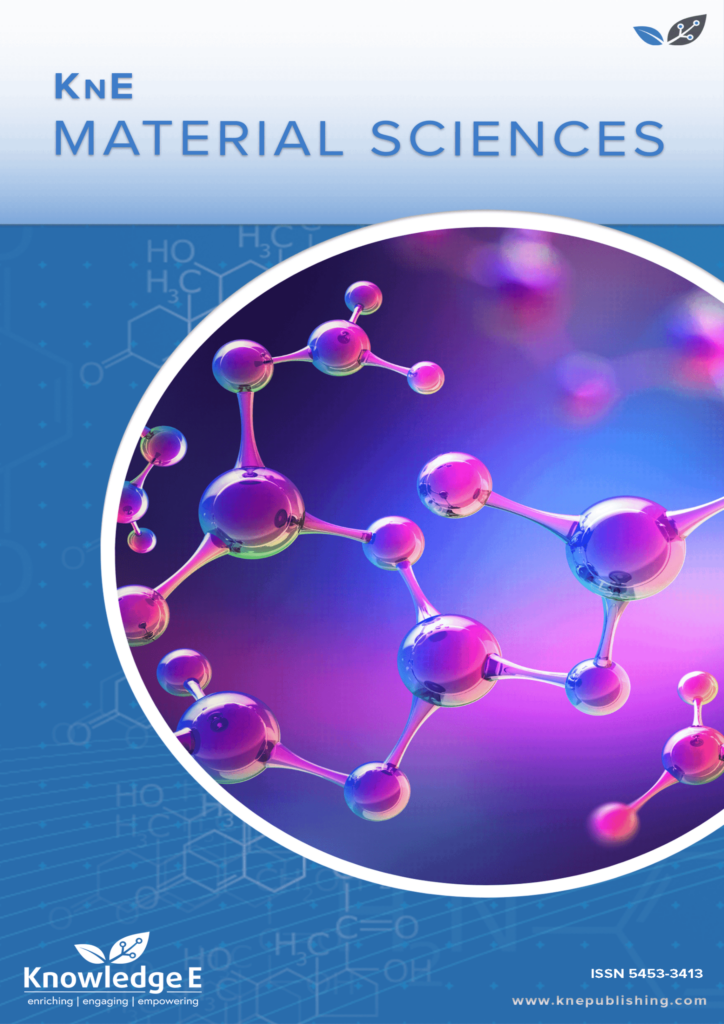
KnE Materials Science
ISSN: 2519-1438
The latest conference proceedings on physical materials, energy materials, electrical materials.
Removal of Emergent Pollutants by a Vertical Flow Constructed Wetland with Vetiveria Zizanioides: A Case Study for Caffeine
Published date: Aug 10 2022
Journal Title: KnE Materials Science
Issue title: 1st International FibEnTech Congress (FibEnTech21) – New Opportunities for Fibrous Materials in the Ecological Transition
Pages: 184–192
Authors:
Abstract:
This work evaluated caffeine removal in a vertical flow constructed wetland (VFCW), planted with Vetiveria zizanioides. The feeding was continuous (synthetic influent: mineral medium and caffeine) to reduce the concentration variations in the bed. Two influent concentrations (0.75 ± 1.0 mg·L−1 and 1.5 ± 1.0 mg·L−1) were used with a constant hydraulic load (100 ± 10 L·m−2·d−1). Plant growth was monitored weekly, and characterization was carried out to determine the levels of chlorophyll a and b, pigments and carotenoids, and nutrients (nitrogen, phosphorus, magnesium, calcium, sodium and potassium). HPLC-MS was used to determine the caffeine concentration. The caffeine removal efficiency reached averages of 93 ± 1% and 87 ± 1% (retention time: 6.23 ± 0.23 hours). The caffeine contents in the influent did not affect chlorophyll a, total chlorophyll or carotenoids, and an increasing trend throughout the tests was observed. Sodium and potassium contents also showed an increase with higher caffeine concentration. This preliminary study showed that removing caffeine from wastewater using a VFCW is promising.
Keywords: wastewater, emergent pollutants, caffeine, vertical flow constructed wetlands, Vetiveria zizanioides
References:
[1] Zhang D, Luo J, Lee ZM, et al. Characterization of microbial communities in wetland mesocosms receiving caffeine-enriched wastewater. Environmental Science and Pollution Research. 2016;23(14):14526-39. https://doi.org/10.1007/s11356-016-6586-4
[2] Hijosa-Valsero M, Reyes-Contreras C, Domínguez C, Bécares E, Bayona JM. Behaviour of pharmaceuticals and personal care products in constructed wetland compartments: Influent, effluent, pore water, substrate, and plant roots. Chemosphere. 2016;145:508-517. https://doi.org/10.1016/j.chemosphere.2015.11.090
[3] Zhang DQ, Hua T, Gersberg RM, Zhu J, Ng WJ, Tan SK. Fate of caffeine in mesocosms wetland planted with Scirpus validus. Chemosphere. 2013;90(4):1568– 1572. https://doi.org/10.1016/j.chemosphere.2012.09.059
[4] Montagner CC, Vidal C, Acayaba RD. Contaminantes emergentes em matrizes aquáticas do Brasil: Cenário atual e aspectos analíticos, ecotoxicológicos e regulatórios. Química Nova. 2017;40(9):1094-1110. https://doi.org/10.21577/0100- 4042.20170091
[5] Wu J, Yue J, Hu R, Yang Z, Zhang L. Use of caffeine and human pharmaceutical compounds to identify sewage contamination. International Journal of Civil and Environmental Engineering. 2010;2(2):98-102. https://doi.org/10.5281/zenodo.1070943
[6] Gracia-Lor E, Castiglioni S, Bade R et al. Measuring biomarkers in wastewater as a new source of epidemiological information: Current state and future perspectives. Environment International. 2017;99:131-150. https://doi.org/10.1016/j.envint.2016.12.016
[7] Ferreira AP. Caffeine as an environmental indicator for assessing urban aquatic ecosystems. Cadernos de Saúde Pública. 2005;21(6):1884-1892. https://doi.org/10.1590/S0102-311X2005000600038
[8] Marasco Júnior CA, Luchiari NC, Gomes PCFL. Occurrence of caffeine in wastewater and sewage and applied techniques for analysis: A review. Eclética Química Journal. 2019;44(4):11-26. https://doi.org/10.26850/1678-4618eqj.v44.4.p11-26
[9] Edwards QA, Kulikov SM, Garner-O’neale LD. Caffeine in surface and wastewaters in Barbados. West Indies Springer Plus. 2015;4(57):1-12. https://doi.org/10.1186/s40064- 015-0809-x
[10] Senta I, Gracia-Lor E, Borsotti A, Zuccato E, Castiglioni S. Wastewater analysis to monitor use of caffeine and nicotine and evaluation of their metabolites as biomarkers for population size assessment. Water Research. 2015;74:23-33. https://doi.org/10.1016/j.watres.2015.02.002
[11] Sossalla NA. Characterization, resilience, and optimization of micropollutant and biological effect removal by treatment wetlands treating municipal wastewater [Thesis to obtain the academic degree Doctor of natural sciences]. Germany; 2021.
[12] Nivala J, Boog J, Headley T et al. Side-by-side comparison of 15 pilotscale conventional and intensified subsurface flow wetlands for treatment of domestic wastewater. Science of the Total Environment. 2019;658:1500–1513. https://doi.org/10.1016/j.scitotenv.2018.12.165
[13] Matamoros V, Arias CA, Brix H, Bayona JM. Removal of pharmaceuticals and personal care products (PPCPs) from urban wastewater in a pilot vertical flow constructed wetland and a sand filter. Environment Science Technology. 2007;41:8171–8177. https://doi.org/10.1021/es071594+
[14] Nivala J, Kahl S, Boog J, van Afferden M, Reemtsma T, Müller RA. Dynamics of emerging organic contaminant removal in conventional and intensified subsurface flow treatment wetlands. Science of the Total Environment. 2019;649:1144–1156. https://doi.org/10.1016/j.scitotenv.2018.08.339
[15] Vymazal J. Proc. conf. The use of aquatic macrophytes for wastewater treatment in constructed wetlands. Dias V, Vymazal J, editors. Lisboa: ICN e INAG; 2003.
[16] Truong P, Hart B. Vetiver system for wastewater treatment. Queensland; 2001. Available from: https://www.vetiver.org/PRVN_wastewater_bul.pdf
[17] The World Bank. Vetiver grass: The hedge against erosion. 4th ed. Washington DC: The World Bank; 1993. Available from: http://www.vetiver.org/PUBLICATIONS/TVN_greenEng.pdf
[18] Kadlec RH, Wallace S. Treatment wetlands. 2nd ed. Boca Raton: Taylor & Francis; 2008.
[19] Dordio AV, Belo M, Teixeira DM et al. Evaluation of carbamazepine uptake and metabolization by Typha spp., a plant with potential use in phytotreatment. Bioresource Technology. 2011;102(17):7827–7834. https://doi.org/10.1016/j.biortech.2011.06.050
[20] Hunter RG, Combs DL, George DB. Nitrogen, phosphorous and organic carbon removal in simulated wetland treatment systems. Archives of Environmental Contamination and Toxicology. 2001;41(3):274–281. https://doi.org/10.1007/s002440010249
[21] APAH. Standard methods for the examination of water and wastewater. 22nd ed. Washington DC: American Public Health Association/American Water Works Association/Water Environment Federation; 2013.
[22] Campbell CR, Plank CO. Handbook of reference method for plant analysis. Kalra YP, editor. Boca Raton: CRC Press; 1998.
[23] Lichtenthaler HK. Chlorophylls and carotenoids: Pigments of photosynthetic biomembranes. Methods In Enzymology. 1987:350-382.
[24] Oliveira M, Atalla AA, Frihling BEF, Cavalheri PS, Migliolo L, Filho FJCM. Ibuprofen and caffeine removal in vertical flow and free-floating macrophyte constructed wetlands with Heliconia rostrata and Eichornia crassipes. Chemical Engineering Journal. 2019;373:458-467. https://doi.org/10.1016/j.cej.2019.05.064